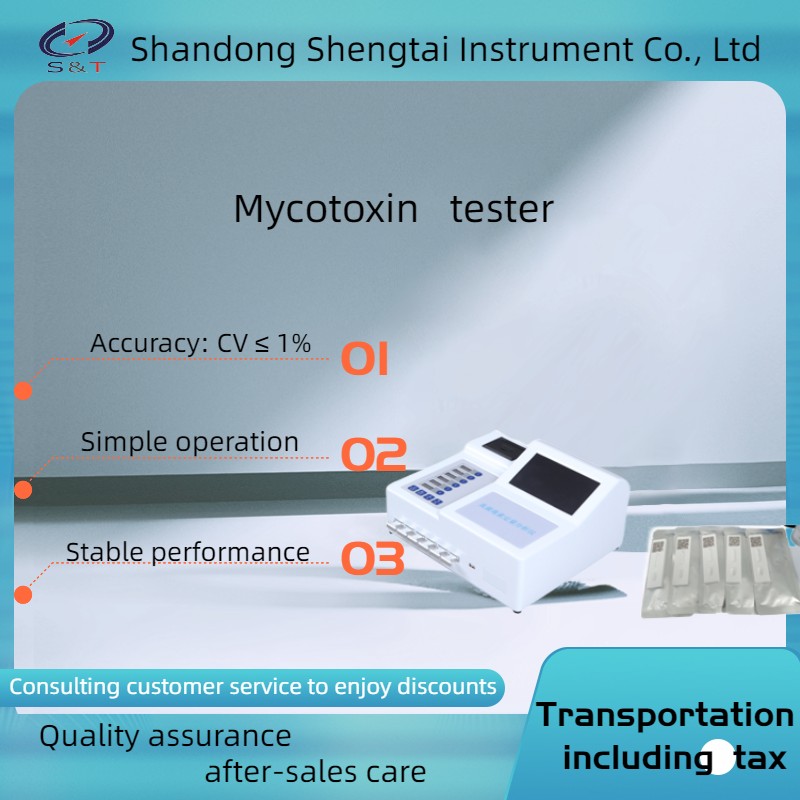ST-2000A
mycotoxin analyzer is a necessary analytical instrument for aflatoxin and
enzyme-linked immunosorbent assay. The principle of solid-phase enzyme-linked
immunosorbent assay (ELISA), namely enzyme-linked immunosorbent assay (ELISA),
is composed of this instrument and B1 kit, which can be used to determine the
content of aflatoxin B1 and other mycotoxins in samples in a limited and
quantitative manner (if equipped with other kits, other toxins can be
detected). It is widely used in the detection of aflatoxin B1 and other
mycotoxins in food, feed, oil, dairy products, drugs, beverages, wine and other
products.
Performance characteristics:
1.
Display operation: color LCD screen, videophone distribution board, display of
whole board information, touch screen operation
2.
Vibrating plate function: Level 3 vibrating plate speed, time 0-255 seconds
adjustable
3.
Workstation: professional enzyme marker software, which can store 500 groups of
programs, 100000 sample results, and provide rich calculation modes such as
absorbance, linear equation, logarithmic equation, quadratic equation, cubic
equation, absorbance percentage-concentration logarithmic equation, spline
function, inhibition rate, etc
Technical
parameters:
Light
source: DC12V 22W imported halogen lamp
Wavelength
range: 400-900nm
Filter:
405, 450, 492, 630nm as standard, other wavelengths optional
Reading
range: 0-4.000Abs
Resolution:
0.001Abs
Indication
error: ≤± 0.01Abs
Stability:
≤± 0.003Abs
Repeatability:
≤ 0.3%
Size:
400mm * 260mm * 200mm
Light
source
DC12V
22W imported halogen lamp
Wave length range
400 - 999nm
Spectral filter
405, 450,
492, 630nm and other regular wavelength
Scope
of readings
0.000 - 4.000Abs
Repeatability
CV≤0.3%
Stability
drift ≤±0.003Abs
Resolution
0.001Abs
Absorbance
indication error
≤±0.01Abs
Size:
400mm * 260mm * 200mm
1 Principle and
application
This kit uses
indirect competitive ELISA method to detect aflatoxin B1 (AFB1) in grains, feed
and other samples. The kit is composed of enzyme-labeled plate pre-coated with coupling
antigen, horseradish enzyme marker, antibody, standard and other matching
reagents. During the test, add the standard or sample solution, the aflatoxin
B1 in the sample and the enzyme plate are pre-coated with the conjugate antigen
to compete for the anti-aflatoxin B1 antibody. After adding the enzyme marker,
use the TMB substrate to develop the color. The sample absorbance value is
negatively correlated with the content of aflatoxin B1 contained in the sample.
The residual amount of aflatoxin B1 in the sample can be obtained by comparing
with the standard curve.
2 Technical indicators
2.1 Kit
sensitivity: 0.03ppb (ng/ml)
2.2 Reaction mode:
25 ℃, 30min~15min
2.3 Lower
detection limit:
Cereals......................................................
0.15ppb
Formula
feed.......................................... 0.3 ppb
Edible oil,
peanut.................................... 0.6ppb
Soy sauce, wheat
and other feeds.............................. 0.3 ppb
Beer..........................................
0.3 ppb
Wine, soy sauce,
vinegar.................................... 0.15ppb
2.4 Cross reaction
rate:
Aflatoxin B1 100%
2.5 Sample recovery
rate:
Cereals and
formula feed.............................. 85% ± 15%
Peanut....................................
82 ± 15%
Edible
oil.................................... 85 ± 15%
Soy sauce, wheat
and other feeds.............................. 83 ± 15%
Beer....................................
84 ± 15%
Wine, soy sauce,
vinegar............ 87 ± 15%
3 Kit composition
Enzyme marker plate....................................
96 holes
Standard solution
(black cover): 1ml each
0ppb、0.03ppb、0.06ppb、0.12ppb、0.24ppb、0.48ppb
High standard
solution: 100ppb.............................. 1ml
Enzyme marker (red
cap).............................. 5.5ml
Antibody working
solution (blue cap).............................. 5.5ml
Substrate solution
A (white cap).............................. 6ml
Substrate liquid B
(black cover).............................. 6ml
Termination
solution (yellow cap).............................. 6ml
20X concentrated
washing solution (white cover)..................... 40ml
Instruction manual.....................1copy
4 Required equipment and reagents
4.1 Apparatus:
aflatoxin tester, printer, homogenizer, nitrogen drying device, oscillator,
centrifuge, graduated pipette, balance (sensitivity 0.01g)
4.2 Micro-pipette:
single-channel 20 µ l-200 µ l, 100 µ l-1000 µ l, multi-channel 300 µ l
4.3 Reagent:
methanol, n-hexane, trichloromethane or dichloromethane
5 Sample pretreatment
5.1 Instructions
before sample processing:
The experimental
apparatus must be clean and use disposable suction head to avoid contamination
and interference with the experimental results.
5.2 Solution
preparation:
Solution 1: sample
extract
70% methanol, i.e.
V methanol: V deionized water=7:3.
5.3 Sample
pretreatment steps:
5.3.1 Grain
processing method
1) Weigh 2g of
crushed sample into a 50ml centrifuge tube, add 5ml of sample extraction
solution, shake for 5 minutes, 4000 rpm at room temperature/10 minutes of
separation center;
2) Take 0.5ml of
supernatant, add 0.5ml of deionized water, and mix well;
3) Take 50 μ L
Analysis.
Sample dilution
ratio: 5 Lower detection limit: 0.15ppb
5.3.2 Processing
methods for samples with strong water absorption such as corn husk and wheat
bran
1) Weigh 2g of
crushed sample into a 50ml centrifuge tube, add 20ml of sample extraction
solution, shake for 5 minutes, 4000 rpm at room temperature/10 minutes of
separation center;
2) Take 0.5ml of
supernatant, add 0.5ml of deionized water, and mix well; (For the sample with
extremely high toxin content, it can be diluted with 35% methanol and then
tested. For example, take 0.1ml of the mixed solution in 2) and 0.9ml of 35%
methanol to mix. The final sample dilution ratio is 200, and the detection
limit is 6ppb.)
3) Take 50 μ L
Analysis.
Sample dilution
ratio: 20 Lower detection limit: 0.6ppb
Note: Because the
distribution of toxin in the sample is uneven, it is necessary to take samples
from multiple points and fully mix them before taking 2g for test.
5.3.3 Processing
method of formula feed
1) Weigh 2g of
crushed sample into a 50ml centrifuge tube, add 10ml of sample extraction
solution, shake for 5 minutes, 4000 rpm at room temperature/10 minutes of
separation center;
2) Take 0.5ml of
supernatant, add 0.5ml of deionized water, and mix well;
3) Take 50 μ L
Analysis.
Sample dilution
ratio: 10 Lower detection limit: 0.3ppb
5.3.4 Feed
treatment methods of edible oil, peanut and high fat
1) Weigh 2g of
crushed sample into a 50ml centrifuge tube, add 8ml of n-hexane and 10ml of
sample extraction solution, shake for 5min, 4000 rpm at room temperature/10 min
of separation center;
2) Remove the
upper liquid, take 0.5ml of the lower liquid and add 0.5ml of deionized water,
mix well, then take 0.5ml of the mixed liquid and add 0.5ml of 35% methanol,
shake for 30s;
3) Take 50 μ L
Analysis.
Sample dilution
ratio: 20 Lower detection limit: 0.6ppb
5.3.5 Food or
condiments such as sauces, wheat, biscuits, pastries, and feed processing
methods such as feed concentrate
1) Weigh 2g of
crushed sample into a 50ml centrifuge tube, add 10ml of sample extraction
solution, shake for 5 minutes, 4000 rpm at room temperature/10 minutes of
separation center;
2) Take 2ml of
supernatant, add 4ml of trichloromethane (or dichloromethane), shake for 5
minutes, 4000 rpm at room temperature/10 minutes of separation center;
3) Transfer the
upper liquid to another container, leave the lower liquid for standby, add
another 4ml of chloroform (or dichloromethane) to the upper liquid, fully shake
and mix for 5 minutes, and the room temperature is 4000 rpm/separation center
for 10 minutes;
4) Remove the
upper liquid, combine the lower liquid twice and fully mix;
5) Take 2ml of the
combined lower liquid and blow it dry under 50-60 ℃ nitrogen;
6) Add 0.5ml of
sample extract to fully dissolve the dried substance, and then add 0.5ml of
deionized water to mix;
7) Take 50 μ L
Analysis.
Sample dilution
ratio: 10 Lower detection limit: 0.3ppb
5.3.6 Beer
processing method
1) Fully stir the
beer (remove CO2), take 2ml of beer sample, add 1ml of distilled water, add 7ml
of methanol, and shake for 5min;
2) Take 0.5ml of
mixed sample solution and add 0.5ml of deionized water to mix well;
3) Take 50 μ L
Analysis.
Sample dilution
ratio: 10 Lower detection limit: 0.3ppb
5.3.7 Treatment
method of wine, soy sauce and vinegar
1) Take 2ml of
sample, add 2ml of distilled water, add 10ml of trichloromethane (or
dichloromethane), shake for 5 minutes, 4000 rpm at room temperature/10 minutes
of separation center;
2) Take 1ml of the
lower liquid and blow it dry under 50-60 ℃ nitrogen;
3) Add 0.5ml of
sample extract to fully dissolve the dried substance, then add 0.5ml of
deionized water, and mix well;
5) Take 50 μ L
Analysis.
Sample dilution
ratio: 5 Lower detection limit: 0.15ppb
6 Steps of ELISA
Take the required
reagent out of the 4 ℃ cold storage environment and place it at room
temperature for more than 30min. There may be crystals that need to be restored
to room temperature to fully dissolve when the washing solution is cold
storage. Each liquid reagent must be shaken before use. Take out the required
number of microporous plates and frames, put the unused microporous plates into
self-sealing bags, and store them at 2-8 ℃.
Before the
experiment, 20 × The concentrated washing solution is diluted into working
washing solution by 20 times.
6.1 Numbering:
number the corresponding wells of the sample and standard in sequence, make two
parallel holes for each sample and standard, and record the position of the
standard hole and sample hole.
6.2 Sample adding
reaction: add 50 µ l/well of standard or sample into their respective wells,
then add 50 µ l/well of enzyme marker, then add 50 µ l/well of antibody working
solution, seal the plate with a cover plate membrane, gently shake for 5
seconds, mix, and react at 25 ℃ for 30 minutes.
6.3 Washing:
Carefully remove the cover plate membrane, dry the liquid in the hole, fully
wash the hole with working washing solution 250 µ l/hole for 5 times, with an
interval of 30 seconds, and pat it dry with absorbent paper (the bubbles that
are not removed after the pat can be punctured with a clean gun head).
6.4 Color
development: add 50 µ l of substrate solution A and 50 µ l of substrate
solution B to each hole, shake gently for 5 seconds and mix well, and develop
color in dark at 25 ℃ for 15 minutes.
6.5 Termination:
add 50 µ l of termination solution to each hole, shake gently and mix well to
terminate the reaction.
6.6 Measurement of
absorbance value: use the aflatoxin tester to measure the absorbance value of
each hole at 450 nm (dual wavelength 450/630 nm is recommended). The
determination shall be completed within 10 minutes after the reaction is
terminated
6.7 The ST-2000A
automatic aflatoxin tester automatically completes the determination and
automatically produces the results.
Company
Introduction
Shandong Shengtai Instruments Co., Ltd. is
specialized in the research and production of experimental testing instruments
and industrial testing instruments. It is a professional instrument company
integrating instrument research and development, manufacturing, sales and service.
Its products are widely used in food, flour, grain and oil, Feed, electricity,
petrochemical, industrial oil, aerospace, coal quality and other industries.
For more than 10 years, Shengtai has always
been adhering to the "first-class service, customer first" as the
purpose, "reasonable price, honesty and trustworthiness" as the
business policy. Adhere to technical innovation, with rich knowledge of the
technical team and experienced, thoughtful after-sales service team.
Shengtai instrument as one of the most
large-scale and competitive enterprises in the industry, with the strength of
technology research and development, professional technical knowledge and
innovative design concept, in the model improvement, Significant technical
breakthrough has been achieved in the development of function expansion and
intelligent control system.
OUR
service
After-sales service commitment, our company
to sell the product after-sales service commitment: warranty period of one
year, long-term technical support outside the warranty period. During the
warranty period, the seller shall bear the cost of the replacement of the
equipment, the freight and maintenance of the instrument; outside the warranty
period, the seller shall waive the maintenance fee and charge only the cost of
the basic materials and freight charges when the instrument is malfunctioning
and the seller shall not charge the maintenance fee during the warranty period.



